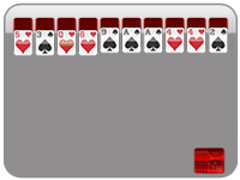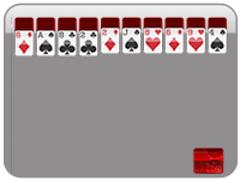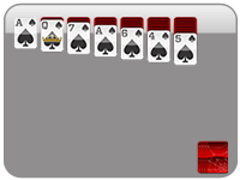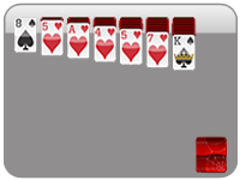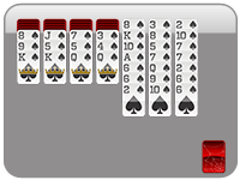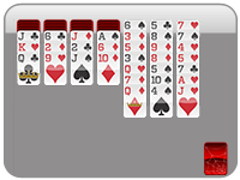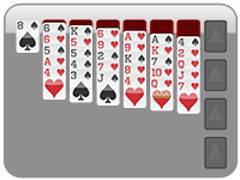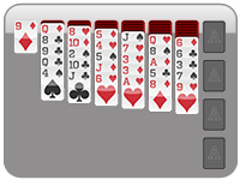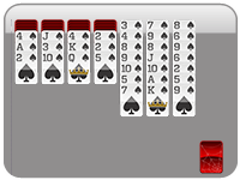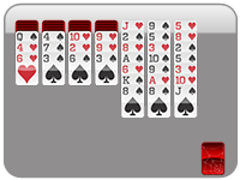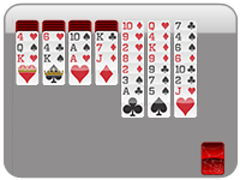Solitaire Tips: Master the Game with These Strategies
Solitaire is a timeless card game that is enjoyed by millions around the world. Contrary to popular belief, the game isn’t just about luck either! With the right strategies, anyone can greatly increase their chances of winning and clearing their board fast.
So no matter if you’re a beginner just trying to understand the rules or a seasoned player looking to master the tricks, this guide is for you. We’ll be focusing on Spider Solitaire, one of the most popular variations of the game. By the end of this article, you’ll have a solid understanding of the basics, essential strategies, and advanced techniques to take your game to the next level.

Understanding Spider Solitaire Basics
Before we get into the strategies and tips, it's important to make sure you understand the basic rules of Spider Solitaire. Even if you've played a lot, a quick review can help ensure you're not missing any key details.
What is Spider Solitaire?
Spider Solitaire is a two-deck card game that challenges you to organize cards into sequences, from King down to Ace, in the same suit. The game is set up with ten columns, and the goal is to clear all the cards from the table by building full sequences in descending order from King to Ace.
The Setup
At the start of the game, 54 cards are dealt into ten columns. The first four columns have six cards each, and the remaining six columns have five cards each. Only the top card of each column pile is faced up, while the rest are hidden underneath. The remaining 50 cards are placed in the stockpile which you'll draw from throughout the game.
The Objective
Your objective is to move cards around the table to create full sequences of cards in the same suit. Once a full sequence is completed, it gets removed from the board. You win the game once all cards are removed from the board.
The Rules
Here’s a quick rundown of the basic rules:
- You can move any face-up card to another column as long as the card you're placing it on is one rank higher. For example, you can move a 9 onto a 10, regardless of suit.
- You can move partial sequences of cards within a column, but only if they're of the same suit and in proper descending order.
- Empty columns can be filled by any card or sequence of cards.
- When you run out of moves, you can deal a fresh row of cards from the stockpile onto the board.
Now that you've got the basics down, let's move on to the essential strategies that’ll help you become a Solitaire master!
Essential Strategies for Every Game
While the rules of Spider Solitaire are straightforward, mastering the game requires a solid strategy. While you can generally follow whatever strategy you want, there are a couple of simple and effective steps to greatly improve your chances of winning.
1. Expose Hidden Cards
One of the most important things you can do in Spider Solitaire is to expose hidden cards as quickly as possible. The sooner you flip those cards, the more options you’ll have for moves.
- Prioritize columns with the fewest hidden cards to reveal them faster.
- Focus on freeing up columns where a single face-down card is left.
- Exposing cards early on helps prevent getting stuck later in the game.
2. Create Empty Columns
Empty columns are a game-changer in Spider Solitaire. They give you a lot of flexibility for rearranging cards, making it easier to move large sequences and start new ones.
- Try to clear a column as soon as you can.
- Once you have an empty column, you can use it to temporarily move cards around, making it easier to organize sequences in other columns.
- Always leave a column empty if you can, instead of filling it right away. An empty column gives you more opportunities later in the game.
3. Focus on Completing Builds of the Same Suit
While you can move cards from one suit onto another, such as placing a 6 of hearts on a 7 of spades, your goal is to complete full sequences in the same suit.
- Always try to create builds using cards from the same suit. This makes it easier to move full sequences around.
- Avoid mixing suits whenever possible. Mixed sequences might help you in the short term, but they can block you from making bigger moves later.
4. Manage the Stockpile Wisely
The stockpile is a set of cards you’ll draw from throughout the game. However, you should only use it when you absolutely need it. Every time you deal a new row of cards, the game becomes more complicated because each column gets a new card.
- Don’t deal new cards until you’ve exhausted all possible moves on the current board.
- Avoid adding cards from the stockpile unless you feel like there are no good moves left.
- Use the stockpile strategically to break up tough situations, but remember that it can also add to the difficulty.
5. Move Kings to Empty Columns
Kings are the hardest cards to move in Spider Solitaire because they can’t be placed on any other cards. However, if you manage to clear an empty column, Kings become much easier to handle.
- Once you create an empty column, move a King to that spot. It opens up space in other columns for more moves.
- Kings can be tricky, so don’t rush to move them if it doesn't benefit your long-term strategy.
By using these essential strategies, you’ll set yourself up for success in any Spider Solitaire game. Now, let's shift focus to some common mistakes that can hold you back.
Common Mistakes to Avoid
Even seasoned players make mistakes, but learning to recognize and avoid these common pitfalls can greatly improve your success rate. Here are some frequent mistakes that can ruin a game and how to avoid them.
1. Ignoring the Importance of Suits
One of the biggest mistakes new players make is ignoring the importance of suits. While it’s tempting to stack cards of different suits when you’re trying to free up space, it can cause big problems later on. Always aim to build suited sequences. Mixing suits might seem harmless at first, but it can limit your ability to move cards around and clear columns later in the game. It also makes it harder to create the full King-to-Ace sequences that are required to win.
When cards of different suits are stacked together, you might find yourself stuck with no way to break them apart without undoing multiple moves or waiting for a specific card that may never appear. By focusing on organizing your cards by suit from the start, you'll keep more flexibility in the game and increase your chances of completing sequences efficiently.
2. Dealing New Cards Too Soon
Another common mistake is dealing new cards too early. As we mentioned before, every new deal brings ten more cards into play, making it harder to manage your board. If you deal new cards before you’ve cleared up enough space, you’re just making things harder for yourself. Always look for every possible move before resorting to the deal button.
Additionally, dealing too soon can create unnecessary obstacles by layering cards over sequences you were close to completing. Patience is key–use all your available moves to clear spaces and reveal cards before hitting the deal button to avoid cluttering your board too soon.
3. Leaving Too Many Face-Down Cards
Sometimes players focus so much on moving cards around that they forget about the ultimate goal: uncovering face-down cards. If you leave too many cards hidden for too long, you’ll find yourself stuck with fewer options. Make it a priority to uncover face-down cards whenever you can, as this will give you more options for future moves.
The more face-down cards you leave, the fewer moves you'll be able to make, limiting your ability to create full sequences. Uncovering cards early on also helps you better plan your moves, reducing the likelihood of getting stuck with no playable options.
4. Filling Empty Columns with Random Cards
When you’ve worked hard to clear a column, the last thing you want to do is fill it up with random cards that don’t help you. Don’t fill empty columns with cards unless it’s part of a plan. Ideally, you should only fill empty columns with cards that will help you reveal more face-down cards or build suited sequences. Otherwise, you’re just limiting your options again.
Randomly filling empty columns can lead to dead ends where you have no choice but to deal more cards or undo progress, so always think ahead and place cards strategically to maximize your chances of success.
5. Playing Without a Strategy
Spider Solitaire is a game that rewards strategy. If you’re playing without a plan, you’re going to lose more often than not. Always have a goal in mind for each move, whether it’s uncovering a face-down card, creating an empty column, or building a suited sequence. Random moves will only take you so far!
Without a clear strategy, you’ll often end up wasting opportunities and locking yourself into unfavorable positions. Instead, think a few moves ahead, considering how each action impacts the overall layout of your cards. For example, prioritizing moves that will reveal hidden cards or free up columns can make the game easier later. Playing thoughtfully and methodically improves your win rate and also makes the game more enjoyable.
Advanced Techniques to Elevate Play
Once you’ve got the basics down and you’re avoiding common mistakes, it’s time to take your game to the next level with some advanced techniques.
1. Use Empty Columns Wisely
We’ve already talked about how important empty columns are, but it’s worth repeating: Empty columns are your best friends in Spider Solitaire. Advanced players know that empty columns give them the flexibility to move large sequences of cards around, which is essential for uncovering hidden cards and completing sequences. But don’t just rush to fill an empty column. If possible, keep it open for as long as you can, only filling it when you absolutely need to.
2. Prioritize Uncovering Hidden Cards
At the advanced level, you’ll want to make uncovering face-down cards your top priority. The more cards you have visible, the more options you’ll have. If you’re deciding between two moves, always pick the one that will reveal a face-down card, even if it doesn’t seem like the best immediate move. The long-term benefits of revealing new cards far outweigh the short-term gains of moving cards around.
3. Break Up Stacks When Necessary
While building large suited sequences is usually the goal, there are times when it’s beneficial to break up a sequence to make other moves possible. This might seem counterintuitive, but it can help you uncover hidden cards or create empty columns. Don’t be afraid to temporarily break up a sequence if it means you can make better moves in the future.
4. Track Your Moves
Some versions of Spider Solitaire will allow you to undo moves, which can be a great way to test different strategies. If you’re playing without an undo option, try to mentally track your previous moves. This will help you avoid getting stuck in a loop and give you a better understanding of which strategies are working and which aren’t. Advanced players are always thinking about their next move and learning from their past ones.
5. Play Multiple Suit Games
If you’ve mastered the one-suit version of Spider Solitaire, it’s time to try your hand at the two- or four-suit versions. These variations add an extra layer of complexity, as you’ll need to pay even more attention to the suits when building sequences. Playing multi-suit games will sharpen your skills and make you a more versatile player.
6. Make the Most of Kings and Aces
Understanding when and how to use Kings and Aces can give you a significant advantage. Kings are key because they can only be moved into empty columns. So if you’ve freed a column, consider whether placing a King there will block more important moves. Aces, on the other hand, are often the smallest in value but incredibly useful when trying to complete sequences. Avoid burying Aces under other cards, as they’re the key to finalizing sequences and ultimately winning the game!
7. Avoid Unnecessary Moves
Not every legal move is a good move. Advanced players know that sometimes it’s better to wait than to rush a move that doesn’t offer any real progress. Moving a card without a strategic reason, like revealing a hidden card or setting up a sequence, can waste valuable time and limit future options. If a move doesn’t directly help your long-term goals, it may be best to skip it and wait for better opportunities!
8. Use the Undo Feature Thoughtfully
If you're playing a version of Spider Solitaire that allows for unlimited undo moves, use this feature as a tool for planning. Don’t hesitate to experiment with different moves to see how they’ll play out. Try one move, and if it doesn’t lead to progress, undo it and try a different approach. However, don’t become overly dependent on undo! Learn to develop a sense of strategy so that you can foresee better moves without constantly relying on a redo option.
9. Balance Short-Term vs. Long-Term Gains
Sometimes you’ll be faced with the choice between a move that provides an immediate benefit, like revealing a face-down card, and one that sets you up for future success, like creating an empty column. Advanced players know how to balance these options. While uncovering a face-down card might help right away, leaving space for larger plays in the future can lead to better results. Weigh your options carefully and think about how today’s move affects tomorrow’s game.
10. Advanced Stockpile Management
When using the stockpile to deal new cards, timing is everything. Try to save dealing from the stockpile until you’ve exhausted every other possible move. The more control you have over the current board, the better you’ll be able to manage the new cards dealt. If you’re in a difficult position, dealing too soon can add even more complexity and bury important cards deeper into the game. Aim to create empty columns or free up space before dealing new cards to maintain control over your board.
Conclusion
Mastering Spider Solitaire takes time, patience, and a solid strategy. With these tips in mind, you’ll be able to improve your game and start winning more consistently. Most importantly, have fun! Spider Solitaire is a game that rewards strategy and critical thinking, and the more you play, the better you’ll get. Keep practicing, stay patient, and before you know it, you’ll be a Spider Solitaire pro.
Spider Solitaire Games
More Solitaire Games
More Games
Spider Solitaire News
Disclaimer
DISCLAIMER: The games on this website are using PLAY (fake) money. No payouts will be awarded, there are no "winnings", as all games represented by 247 Games LLC are free to play. Play strictly for fun.


